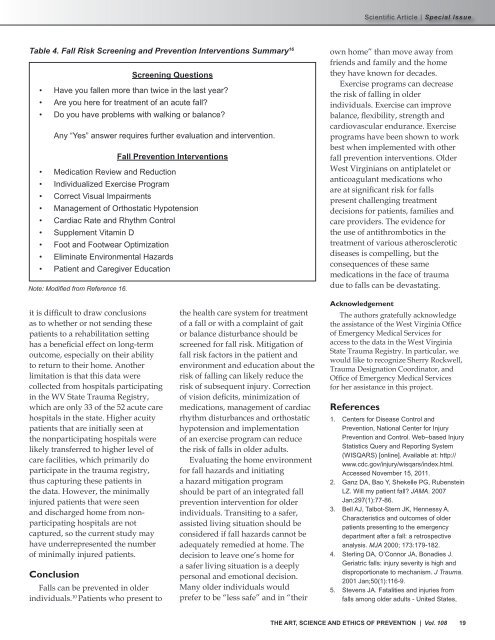Special CME Issue - West Virginia State Medical Association
Special CME Issue - West Virginia State Medical Association
Special CME Issue - West Virginia State Medical Association
Create successful ePaper yourself
Turn your PDF publications into a flip-book with our unique Google optimized e-Paper software.
Table 4. Fall Risk Screening and Prevention Interventions Summary 16<br />
Screening Questions<br />
• Have you fallen more than twice in the last year?<br />
• Are you here for treatment of an acute fall?<br />
• Do you have problems with walking or balance?<br />
Any “Yes” answer requires further evaluation and intervention.<br />
Fall Prevention Interventions<br />
• Medication Review and Reduction<br />
• Individualized Exercise Program<br />
• Correct Visual Impairments<br />
• Management of Orthostatic Hypotension<br />
• Cardiac Rate and Rhythm Control<br />
• Supplement Vitamin D<br />
• Foot and Footwear Optimization<br />
• Eliminate Environmental Hazards<br />
• Patient and Caregiver Education<br />
Note: Modified from Reference 16.<br />
own home” than move away from<br />
friends and family and the home<br />
they have known for decades.<br />
Exercise programs can decrease<br />
the risk of falling in older<br />
individuals. Exercise can improve<br />
balance, flexibility, strength and<br />
cardiovascular endurance. Exercise<br />
programs have been shown to work<br />
best when implemented with other<br />
fall prevention interventions. Older<br />
<strong>West</strong> <strong>Virginia</strong>ns on antiplatelet or<br />
anticoagulant medications who<br />
are at significant risk for falls<br />
present challenging treatment<br />
decisions for patients, families and<br />
care providers. The evidence for<br />
the use of antithrombotics in the<br />
treatment of various atherosclerotic<br />
diseases is compelling, but the<br />
consequences of these same<br />
medications in the face of trauma<br />
due to falls can be devastating.<br />
it is difficult to draw conclusions<br />
as to whether or not sending these<br />
patients to a rehabilitation setting<br />
has a beneficial effect on long-term<br />
outcome, especially on their ability<br />
to return to their home. Another<br />
limitation is that this data were<br />
collected from hospitals participating<br />
in the WV <strong>State</strong> Trauma Registry,<br />
which are only 33 of the 52 acute care<br />
hospitals in the state. Higher acuity<br />
patients that are initially seen at<br />
the nonparticipating hospitals were<br />
likely transferred to higher level of<br />
care facilities, which primarily do<br />
participate in the trauma registry,<br />
thus capturing these patients in<br />
the data. However, the minimally<br />
injured patients that were seen<br />
and discharged home from nonparticipating<br />
hospitals are not<br />
captured, so the current study may<br />
have underrepresented the number<br />
of minimally injured patients.<br />
Conclusion<br />
Falls can be prevented in older<br />
individuals. 10 Patients who present to<br />
the health care system for treatment<br />
of a fall or with a complaint of gait<br />
or balance disturbance should be<br />
screened for fall risk. Mitigation of<br />
fall risk factors in the patient and<br />
environment and education about the<br />
risk of falling can likely reduce the<br />
risk of subsequent injury. Correction<br />
of vision deficits, minimization of<br />
medications, management of cardiac<br />
rhythm disturbances and orthostatic<br />
hypotension and implementation<br />
of an exercise program can reduce<br />
the risk of falls in older adults.<br />
Evaluating the home environment<br />
for fall hazards and initiating<br />
a hazard mitigation program<br />
should be part of an integrated fall<br />
prevention intervention for older<br />
individuals. Transiting to a safer,<br />
assisted living situation should be<br />
considered if fall hazards cannot be<br />
adequately remedied at home. The<br />
decision to leave one’s home for<br />
a safer living situation is a deeply<br />
personal and emotional decision.<br />
Many older individuals would<br />
prefer to be “less safe” and in “their<br />
Acknowledgement<br />
The authors gratefully acknowledge<br />
the assistance of the <strong>West</strong> <strong>Virginia</strong> Office<br />
of Emergency <strong>Medical</strong> Services for<br />
access to the data in the <strong>West</strong> <strong>Virginia</strong><br />
<strong>State</strong> Trauma Registry. In particular, we<br />
would like to recognize Sherry Rockwell,<br />
Trauma Designation Coordinator, and<br />
Office of Emergency <strong>Medical</strong> Services<br />
for her assistance in this project.<br />
References<br />
1. Centers for Disease Control and<br />
Prevention, National Center for Injury<br />
Prevention and Control. Web–based Injury<br />
Statistics Query and Reporting System<br />
(WISQARS) [online]. Available at: http://<br />
www.cdc.gov/injury/wisqars/index.html.<br />
Accessed November 15, 2011.<br />
2. Ganz DA, Bao Y, Shekelle PG, Rubenstein<br />
LZ. Will my patient fall? JAMA. 2007<br />
Jan;297(1):77-86.<br />
3. Bell AJ, Talbot-Stern JK, Hennessy A.<br />
Characteristics and outcomes of older<br />
patients presenting to the emergency<br />
department after a fall: a retrospective<br />
analysis. MJA 2000; 173:179-182.<br />
4. Sterling DA, O’Connor JA, Bonadies J.<br />
Geriatric falls: injury severity is high and<br />
disproportionate to mechanism. J Trauma.<br />
2001 Jan;50(1):116-9.<br />
5. Stevens JA. Fatalities and injuries from<br />
falls among older adults - United <strong>State</strong>s,<br />
THE ART, SCIENCE AND ETHICS OF PREVENTION | Vol. 108 19















